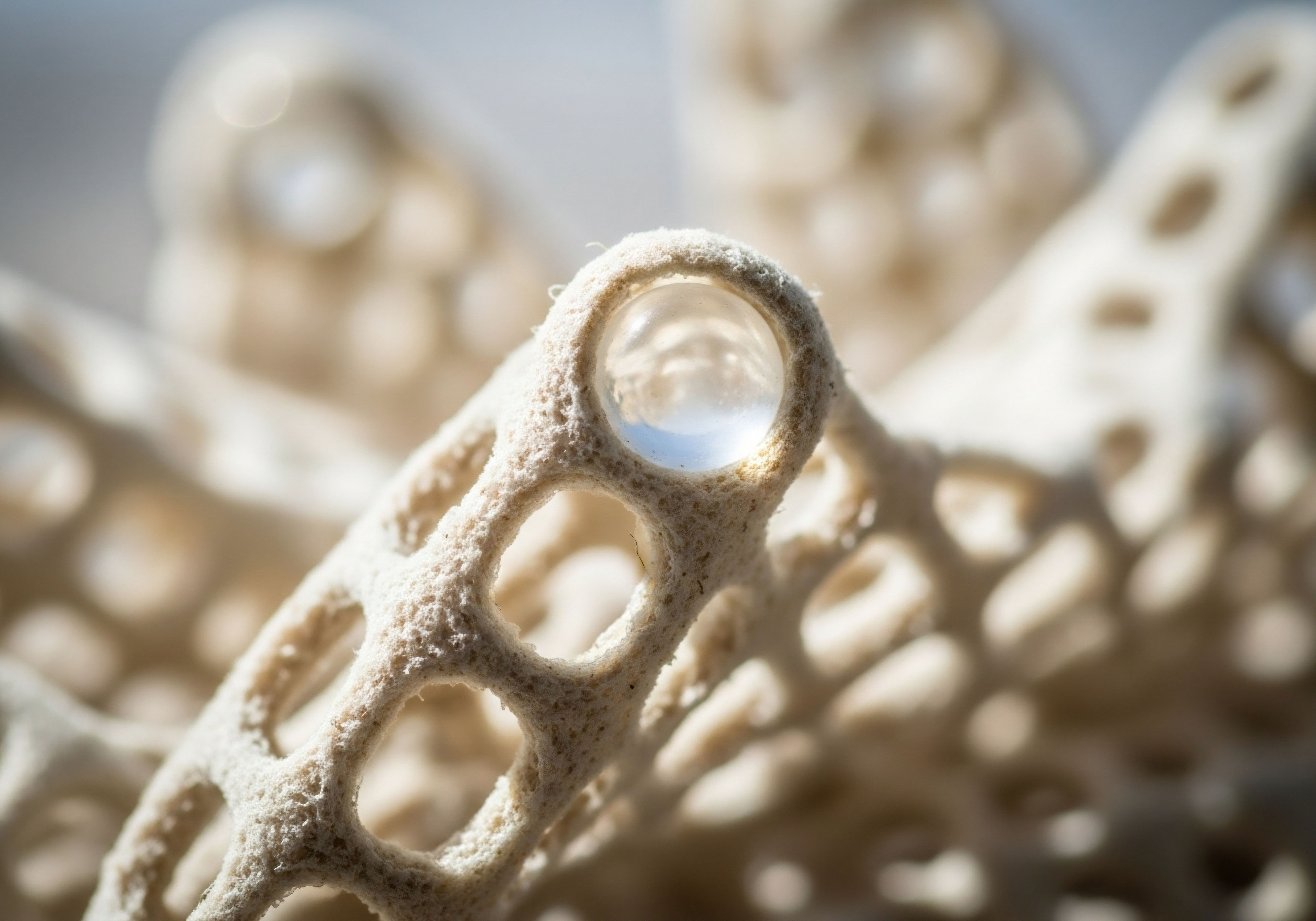

Fundamentals
You feel it before you can name it. A subtle shift in energy, a change in your body’s resilience, or a quiet dimming of your internal drive. These experiences are valid and deeply personal, originating within the intricate, silent chemistry of your body.
Your vitality is directly connected to a complex biological architecture, and understanding its foundation is the first step toward reclaiming your sense of self. The conversation about hormonal health often centers on the hormones themselves, yet the true starting point is far smaller and more fundamental. It begins with the micronutrients that act as the essential raw materials for your entire endocrine system.
Think of your body’s ability to produce testosterone as a highly sophisticated manufacturing process. This process relies on a precise set of tools and components to function correctly. Micronutrients, which are the vitamins and minerals obtained from your diet, are these critical components.
They are the gears, switches, and catalysts that permit the assembly line to run smoothly. Without an adequate supply of these microscopic elements, the entire system can slow down, leading to the symptoms you may be experiencing, such as fatigue or a decline in muscle mass. Your body possesses an innate blueprint for wellness; providing it with the necessary building blocks is how you support that design.

The Essential Building Blocks of Hormonal Health
Your endocrine system is a network of glands that communicates using hormones, with testosterone being a key messenger for maintaining muscle, bone density, and metabolic regulation. The production of this vital hormone is not an abstract event. It is a biological process grounded in biochemistry, heavily dependent on specific micronutrients.
Each one has a distinct and indispensable role. A deficiency in even one of these core nutrients can create a bottleneck in the production pathway, affecting not just testosterone levels but your overall physiological equilibrium.
The journey to hormonal balance begins with supplying your body the essential micronutrient cofactors it requires for hormone synthesis.
For instance, the mineral zinc is directly involved in the creation of testosterone within the testes. Concurrently, vitamin D, often called the “sunshine vitamin,” functions almost like a pro-hormone itself, with cellular receptors for it located directly in testicular tissue where testosterone is made.
This demonstrates a direct, physical link between the nutrient and the hormone-producing machinery. Understanding this relationship moves the conversation from one of mysterious symptoms to one of actionable, biological support. It allows you to see your body as a system you can collaborate with, providing the precise elements it needs to function optimally.


Intermediate
To truly grasp how micronutrients govern testosterone, we must look at the body’s primary hormonal control system the Hypothalamic-Pituitary-Gonadal (HPG) axis. This is the central command pathway regulating male and female reproductive function and hormone production. The hypothalamus, a region in the brain, releases Gonadotropin-Releasing Hormone (GnRH).
This signals the pituitary gland to release Luteinizing Hormone (LH) and Follicle-Stimulating Hormone (FSH). For men, LH travels through the bloodstream to the Leydig cells in the testes, where it initiates the conversion of cholesterol into testosterone. This entire cascade is a finely tuned feedback loop, and micronutrients are the critical facilitators at nearly every step.
Micronutrients function as essential cofactors for the enzymes that drive these hormonal conversions. An enzyme is a protein that accelerates a specific chemical reaction, but it often requires a non-protein helper, or cofactor, to become active. Many of these cofactors are the vitamins and minerals we consume.
A deficiency means the enzyme cannot perform its job efficiently, disrupting the entire production chain. Zinc, for example, is a necessary cofactor for enzymes involved in the synthesis of LH. An insufficient supply of zinc can therefore lead to reduced LH signals from the pituitary, resulting in lower testosterone output from the testes, irrespective of how healthy the testicular tissue is.

Key Micronutrients in the Testosterone Synthesis Pathway
Different micronutrients have highly specific roles within the HPG axis and subsequent metabolic pathways for testosterone. Their functions are distinct and synergistic, meaning they often work together to maintain hormonal equilibrium. Understanding their individual contributions clarifies why a broad-spectrum approach to nutrition is so important for endocrine health.
Here is a breakdown of how some of the most impactful micronutrients influence testosterone production and metabolism:
- Zinc ∞ This mineral is fundamental to the HPG axis. It is required for the synthesis and secretion of LH from the pituitary gland. Zinc also plays a role in the conversion of testosterone to its more bioactive form, dihydrotestosterone (DHT), by acting as a cofactor for the 5α-reductase enzyme.
- Vitamin D ∞ This secosteroid hormone has receptors directly on the Leydig cells, indicating its direct involvement in testosterone synthesis. Men with adequate vitamin D levels consistently show higher testosterone concentrations than those who are deficient.
- Magnesium ∞ This mineral is involved in hundreds of biochemical reactions. Pertaining to testosterone, magnesium helps to reduce the activity of Sex Hormone-Binding Globulin (SHBG), a protein that binds to testosterone and makes it inactive. By limiting SHBG’s binding capacity, magnesium increases the amount of free, bioavailable testosterone in the bloodstream.
- Boron ∞ A trace mineral that has been shown to increase free testosterone levels. It appears to influence the metabolism of other hormones and may also reduce SHBG levels, similar to magnesium.

How Do Micronutrients Regulate Hormonal Balance?
The influence of micronutrients extends beyond simple production. They also regulate how testosterone and other hormones, like estrogen, are metabolized and balanced within the body. Zinc, for instance, also acts as an inhibitor of aromatase, the enzyme that converts testosterone into estrogen. Maintaining sufficient zinc levels can therefore support a healthy testosterone-to-estrogen ratio, which is vital for both male and female physiology.
Micronutrients act as the gatekeepers of hormonal conversion, directing testosterone to its active forms while managing its conversion to other hormones like estrogen.
This regulatory function is a critical aspect of hormonal wellness. The goal is an optimal balance, where hormones are produced adequately and metabolized efficiently. Micronutrient status is a foundational determinant of this balance, directly influencing the enzymatic pathways that govern the body’s entire endocrine landscape.
| Micronutrient | Primary Mechanism of Action | Effect on Testosterone | Associated Biological System |
|---|---|---|---|
| Zinc | Cofactor for LH synthesis and 5α-reductase; inhibitor of aromatase. | Supports production and bioavailability; modulates estrogen conversion. | HPG Axis, Testicular Function |
| Vitamin D | Direct action on Leydig cell receptors; gene transcription. | Directly supports testosterone synthesis. | Endocrine System, Testicular Function |
| Magnesium | Reduces SHBG binding activity. | Increases free, bioavailable testosterone. | Metabolic Health, Circulatory System |
| Boron | Modulates SHBG and steroid hormone metabolism. | Increases free testosterone. | Endocrine System, Mineral Metabolism |


Academic
A sophisticated analysis of testosterone synthesis and metabolism reveals a complex interplay of genomic signaling, enzymatic kinetics, and substrate availability, all profoundly influenced by micronutrient status. The biochemical journey from cholesterol to testosterone is a multi-step process occurring within the mitochondria and endoplasmic reticulum of testicular Leydig cells.
This process, known as steroidogenesis, is governed by a series of enzymes whose expression and activity are rate-limiting factors. Micronutrients function at this granular level, serving as indispensable components of the enzymatic machinery and as signaling molecules that regulate gene expression for these very enzymes.
Vitamin D, for example, exerts its influence through both genomic and non-genomic pathways. The Vitamin D Receptor (VDR) is a nuclear receptor found on Leydig cells. When the active form of vitamin D, 1,25-dihydroxyvitamin D, binds to the VDR, it forms a heterodimer with the Retinoid X Receptor (RXR).
This complex then binds to Vitamin D Response Elements (VDREs) on the DNA, initiating the transcription of genes involved in testosterone synthesis. This is a direct genomic mechanism through which vitamin D status can upregulate the cellular machinery for producing testosterone. This highlights a direct causal link between circulating vitamin D levels and the steroidogenic capacity of the testes.

Enzymatic Regulation through Micronutrient Cofactors
The conversion of testosterone into its various metabolites is controlled by specific enzymes that are themselves dependent on micronutrient cofactors. Two of the most clinically significant enzymes in androgen metabolism are 5α-reductase and aromatase. Their activity dictates the balance between testosterone, dihydrotestosterone (DHT), and estradiol.
- 5α-Reductase ∞ This enzyme converts testosterone into DHT, a more potent androgen responsible for many of testosterone’s masculinizing effects. Zinc is a crucial cofactor for 5α-reductase. A deficiency in zinc can impair this conversion, leading to a lower DHT-to-testosterone ratio, which has physiological implications for tissues that are highly responsive to DHT, such as the prostate and hair follicles.
- Aromatase ∞ This enzyme, a member of the cytochrome P450 superfamily, converts androgens (like testosterone) into estrogens (like estradiol). Zinc functions as a competitive inhibitor of aromatase. By competing for binding sites on the enzyme, zinc can modulate the rate of aromatization, thereby helping to maintain a healthy androgen-to-estrogen balance. This is a critical mechanism for preventing symptoms of estrogen dominance in both men and women.
The balance of androgenic and estrogenic activity is dynamically modulated by the enzymatic activity of 5α-reductase and aromatase, both of which are directly influenced by micronutrient availability.

What Are the Broader Implications for Metabolic Health?
The influence of these micronutrient-dependent pathways extends to systemic metabolic health. Testosterone itself has a significant impact on insulin sensitivity and body composition. By supporting optimal testosterone levels, micronutrients indirectly contribute to metabolic regulation. For instance, magnesium is not only involved in increasing free testosterone but is also a critical cofactor for enzymes in the glycolysis and insulin signaling pathways.
Therefore, a deficiency in magnesium can simultaneously impair testosterone bioavailability and glucose metabolism, creating a compounded negative effect on overall health. This interconnectedness demonstrates that hormonal optimization and metabolic wellness are deeply intertwined at the biochemical level.
| Enzyme | Function | Required Micronutrient Cofactor | Impact of Deficiency |
|---|---|---|---|
| 5α-Reductase | Converts Testosterone to DHT | Zinc | Reduced DHT levels; altered androgenic activity. |
| Aromatase (CYP19A1) | Converts Testosterone to Estradiol | Zinc (as an inhibitor) | Increased aromatization; potential estrogen dominance. |
| Luteinizing Hormone (LH) Synthesis Enzymes | Produce LH in the pituitary | Zinc | Decreased LH signal; reduced stimulus for testosterone production. |
| Steroidogenic Acute Regulatory (StAR) Protein | Transports cholesterol into mitochondria (rate-limiting step) | Vitamin A (Retinoic Acid) | Impaired initiation of steroidogenesis. |
Furthermore, the relationship between Vitamin A and testosterone production offers another layer of molecular insight. Vitamin A, in its active form of retinoic acid, is essential for the expression of the Steroidogenic Acute Regulatory (StAR) protein.
The StAR protein facilitates the transport of cholesterol from the outer to the inner mitochondrial membrane, which is the absolute rate-limiting step in the entire steroidogenic pathway. A deficiency in Vitamin A can therefore bottleneck testosterone production at its very inception, demonstrating that multiple micronutrients must be present in sufficient quantities to support the entire cascade from start to finish.

References
- Pizzorno, L. (2015). Nothing Boring About Boron. Integrative Medicine ∞ A Clinician’s Journal, 14(4), 35 ∞ 48.
- Cinar, V. Polat, Y. Baltaci, A. K. & Mogulkoc, R. (2011). Effects of magnesium supplementation on testosterone levels of athletes and sedentary subjects at rest and after exhaustion. Biological Trace Element Research, 140(1), 18 ∞ 22.
- Prasad, A. S. Mantzoros, C. S. Beck, F. W. Hess, J. W. & Brewer, G. J. (1996). Zinc status and serum testosterone levels of healthy adults. Nutrition, 12(5), 344 ∞ 348.
- Pilz, S. Frisch, S. Koertke, H. Kuhn, J. Dreier, J. Obermayer-Pietsch, B. Wehr, E. & Zittermann, A. (2011). Effect of vitamin D supplementation on testosterone levels in men. Hormone and Metabolic Research, 43(3), 223 ∞ 225.
- Te, L. & Liu, J. (2013). An update on the role of zinc in the pathogenesis of insulin resistance and diabetes. The Journal of Nutrition, 143(6), 791 ∞ 797.
- Fallah, A. Mohammad-Hasani, A. & Colagar, A. H. (2018). Zinc is an Essential Element for Male Fertility ∞ A Review of Roles in Sperm Creation, Quality and Fertilization. Journal of Reproduction & Infertility, 19(2), 69 ∞ 81.
- Zhu, X. & Cheng, C. Y. (2010). The role of retinoic acid in the testis. American Journal of Physiology-Endocrinology and Metabolism, 299(2), E163-E174.
- Christakos, S. Dhawan, P. Verstuyf, A. Verlinden, L. & Carmeliet, G. (2016). Vitamin D ∞ Metabolism, Molecular Mechanism of Action, and Pleiotropic Health Effects. Physiological Reviews, 96(1), 365 ∞ 408.
- Granner, D. K. & Weil, P. A. (2018). Harper’s Illustrated Biochemistry (31st ed.). McGraw-Hill Education.
- Boron, W. F. & Boulpaep, E. L. (2016). Medical Physiology (3rd ed.). Elsevier.

Reflection

Charting Your Own Biological Course
The information presented here provides a map of the intricate biological processes that govern your hormonal health. This knowledge is a powerful tool, shifting the perspective from one of passive experience to one of active participation. You have seen how the smallest components, the micronutrients you consume, form the very foundation of your vitality. The feelings and symptoms you experience are real, and they are rooted in this complex and logical system.
Consider your own health journey. Where do you see intersections between your lifestyle, your nutrition, and how you feel day to day? This understanding is the first and most significant step. The path to sustained wellness is a personal one, built on a foundation of self-awareness and informed action.
The next step involves translating this foundational knowledge into a personalized strategy, a process that recognizes your unique biochemistry and goals. Your body is ready to respond when given the right tools. The journey forward is about discovering which tools you need and how to use them effectively.

Glossary

endocrine system

testosterone levels

leydig cells

hpg axis

testosterone production

testosterone synthesis

sex hormone-binding globulin

shbg

free testosterone

steroidogenesis

micronutrient cofactors




